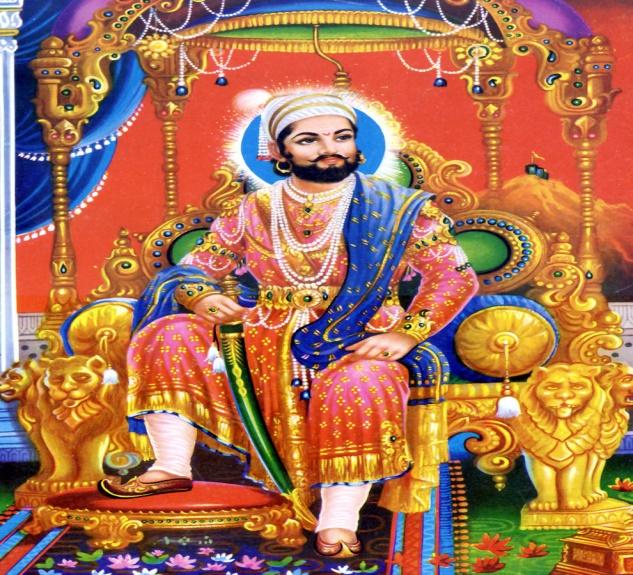MARATHAS(1649-1748)
At the beginning of the 17th century, most of the territory in the Maharashtra were under the position of Nizamshah of Ahmednagar and the Adilshah of Bijapur. They took the help of local, Marathi speaking people to run their administration. They recruited a large number of Maratha sardas and soldiers in their armies.
Shahji Bhonsle (1627-1680): The Bhonsle family of the Poona district acquired military and political advantage in the Ahmadnagar kingdom at the close of the 16th century. Shahji Bhonsle was married to Jija Bai. He sought fortune under the Sultan of Bijapur and had his Jagir at Poona.
Shivaji (1627-1680 A.D.) :- Shivaji was the son of Shahji Bhonsle. When he was 14 years old, his father entrusted the administration of the Pune Jagir to him. Shivaji's responded to the aspiration of masses. Shivaji realised that he could establish a welfare state for the benefit of his subjects only by controlling the neighbouring forts and building new ones.
Shivaji showed his mettle at the young age of 18, when he overrun a number of hill forts near Poona- Rajgarh, Kondana and Torana during 1645-1647. Shivaji became his real career of conquest in 1656, when he conquered Javli from the Maratha Chief, Chandra Rao More. The Mughal invasion of Bijapur in 1657 saved Shivaji from the latter's reprisal. Shivaji visit to Agra: Shivaji reached Agra in 1666, and was admitted in the hall of public audience. The emperor gave him a cold reception by making him stand among the mansabdars. A humiliated and angry Shivaji walked out of the court. He, along with his son, was put under house arrest. However, they tricked their guards and managed to escape in a basket of sweets which was to be sent as a gift to the consolidating his position and reorganising his administration, Shivaji renewed his was against the Mughals and gradully recovered many of his forts.

At the beginning of the 17th century, most of the territory in the Maharashtra were under the position of Nizamshah of Ahmednagar and the Adilshah of Bijapur. They took the help of local, Marathi speaking people to run their administration. They recruited a large number of Maratha sardas and soldiers in their armies.
Shahji Bhonsle (1627-1680): The Bhonsle family of the Poona district acquired military and political advantage in the Ahmadnagar kingdom at the close of the 16th century. Shahji Bhonsle was married to Jija Bai. He sought fortune under the Sultan of Bijapur and had his Jagir at Poona.
Shivaji (1627-1680 A.D.) :- Shivaji was the son of Shahji Bhonsle. When he was 14 years old, his father entrusted the administration of the Pune Jagir to him. Shivaji's responded to the aspiration of masses. Shivaji realised that he could establish a welfare state for the benefit of his subjects only by controlling the neighbouring forts and building new ones.
Shivaji showed his mettle at the young age of 18, when he overrun a number of hill forts near Poona- Rajgarh, Kondana and Torana during 1645-1647. Shivaji became his real career of conquest in 1656, when he conquered Javli from the Maratha Chief, Chandra Rao More. The Mughal invasion of Bijapur in 1657 saved Shivaji from the latter's reprisal. Shivaji visit to Agra: Shivaji reached Agra in 1666, and was admitted in the hall of public audience. The emperor gave him a cold reception by making him stand among the mansabdars. A humiliated and angry Shivaji walked out of the court. He, along with his son, was put under house arrest. However, they tricked their guards and managed to escape in a basket of sweets which was to be sent as a gift to the consolidating his position and reorganising his administration, Shivaji renewed his was against the Mughals and gradully recovered many of his forts.
Important Events In Shivaji's Life
|
|
Shivaji Adminstration: Shivaji laid the foundation of a sound system of administration. Shivaji system of administration was a largely borrowed from the administrative practice of the Deccan States. Although he designated eight ministers, sometimes called the Ashtapradhan it was not in the nature of the Council of ministers, each minister being directly responsible to the ruler.
Military system : In Army administration, Shivaji prefer to give cash raise to the regular soldiers, though sometimes the Chief received revenue grants. The regular army consisting of about 30,000 to 40,000.
Shivaji laid the foundation of a strong state by curbing the power of deshmukhs . The Army was an effective instrument of his policies where rapidity of movement was the most important factor. The army dependent for its salaries to a considerable extent on the plunder of the neighbouring areas.
No comments:
Post a Comment